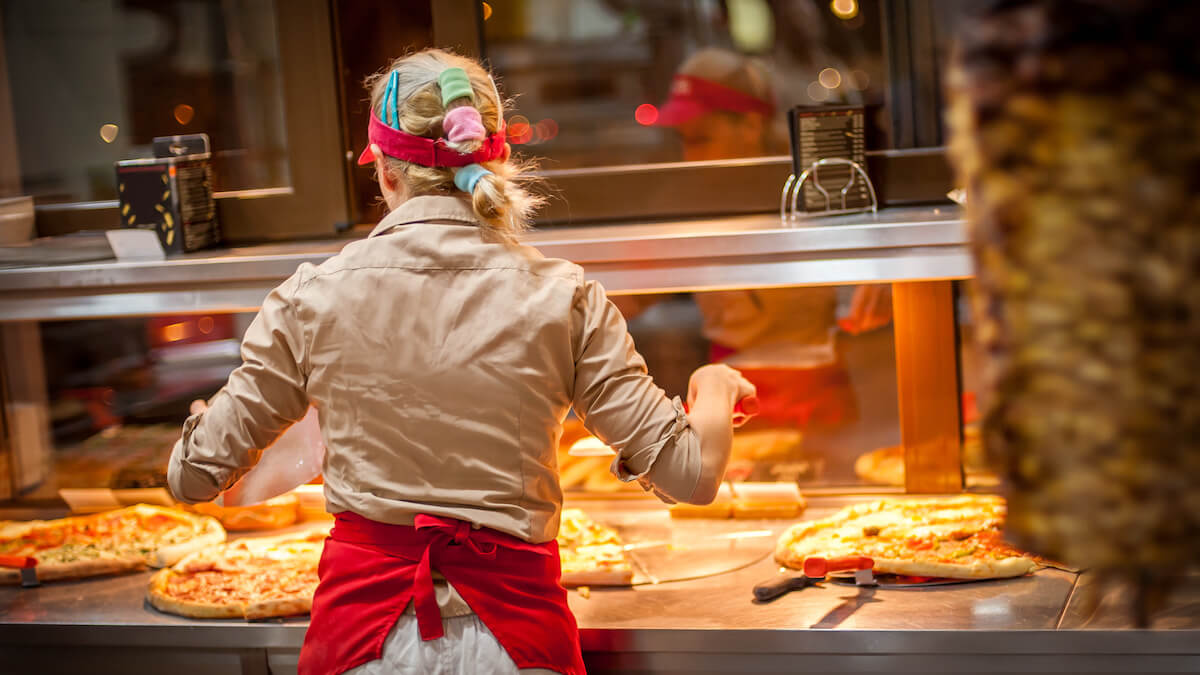Key Takeaways:
Artificial intelligence (AI) technology applications, including voice AI, are now fixtures of contemporary business operations and consumer tech. We can expect this trend to continue, as ongoing advancements in machine learning techniques forecast an even greater role for AI in the years to come.
AI automation—such as voice AI-based restaurant ordering platforms—assist team members by shifting labor from repetitive, time-consuming tasks to revenue-generating priorities such as fulfilling orders and in-person service. But what is conversational AI? How can restaurant owners use it to improve their profits, boost team morale and productivity, and enhance their guests’ experiences?

McKinsey’s 2021 state of AI report recorded an AI adoption rate of 56%, up from 50% in 2020. Moreover, artificial intelligence’s applicability to multiple industries—from e-commerce to healthcare to social media—ensures that these figures will continue to grow.
These developments promise a brighter future for the restaurant industry. In 2022, restaurants grapple with unfilled positions, staffing shortages and unhappy guests. Emerging AI technology should tip the balance towards revenue growth and increased guest satisfaction. Some examples of the most widely used types of AI technology include:
AI chatbots have numerous uses, but businesses frequently use them for customer service interactions. This limits the need to deploy agents in customer support functions and, for example, run call center operations, enabling management to use team members in higher-value customer interactions or other duties altogether.
The same principle holds true in the restaurant industry: AI chatbot platforms work alongside restaurant staff to quickly and efficiently resolve customer service questions and concerns, directly leading to an improved guest experience.
Juniper Research statistics indicate that by 2024, voice assistant devices will outnumber the world population. Digital voice assistants like Alexa and Siri already are not novelties, as they process speech and perform sophisticated operations across multiple integrated devices in homes across the country.
Restaurant AI ordering assistants operate similarly. Drive-thru kiosks, phone ordering networks and front-of-house POS systems can all use voice AI platforms to receive guest orders verbally or in text.
Google Home and similar smart home applications serve as a hub for various synced smart devices and smart appliances within a consumer’s residence. In addition to the convenience of remotely operating multiple devices from a single app, owners of smart homes benefit from their appliances’ capacity to learn from experience. For example, if you consistently set the thermostat to a specific temperature at a particular time, the thermostat will eventually adjust its settings automatically.
Restaurant management apps deliver similar results for quick-service restaurant owners. Much like smart home apps, smart QSR management apps make it easier for owners to carry out a variety of logistical operations in one place. For example, some management apps can predict future shift schedules based on past patterns, eliminating the clunky process of starting from scratch every week.

Conversational AI and voice AI are terms that can be used interchangeably. In short, conversational AI is a type of artificial intelligence capable of speech recognition, machine learning and natural language processing (NLP). These concepts may sound complicated off the bat, but are simple enough to understand when broken down.
Conversational artificial intelligence devices differ from chatbots in several distinct ways. For example, cutting-edge voice AI systems aren’t scripted; instead, they use natural language understanding (NLU) and natural language generation (NLG) in real-time to interpret and reply to text and/or speech. In effect, NLU is hearing or reading language and recognizing its meaning and NLG is the process of responding to speech. For example, basic chatbots often rely on a predetermined list of question and answer sequences, whereas modern voice AI engages in a real conversation with the user.
Voice AI applications rely on a feedback loop of natural language processing and machine learning algorithms. As the name implies, machine learning refers to an AI application’s ability to learn from experience and use that experience to make predictions. For example, if a returning diner calls a restaurant and the voice AI recognizes that person’s number, they will verbally suggest the guest order the same thing they did last time and offer customized menu upsells.
Natural language processing describes the sequence of user-to-AI communication and the AI’s language fluency. Users first speak to the AI out loud or type in their question or request. The application then processes this information and responds appropriately. Finally, the AI records the exchange and uses the memory to improve future performance.
For example, restaurant drive-thru kiosks equipped with voice AI technology greet guests, accept their menu orders and relay those orders to the kitchen. With each customer interaction, the AI improves its speed, accuracy and ability to suggest menu additions or upgrades.
Restaurant voice AI platforms are one of the most promising emerging technologies, and food service outlet managers who choose to adopt conversational AI can expect rapid results.
Labor shortages continue to hinder quick-service restaurant operations. Moreover, restaurants may not be able to fill open jobs or retain their employees over the long-term. Restaurant conversational AI ordering assistants mitigate this by supplementing understaffed workforces and increasing revenue through superior performance.
For example, voice AI assistants greatly increase the number of fulfilled orders, including doubling volume during peak hours. They also improve order accuracy and boost team morale by limiting job stress. All in all, restaurant ordering assistants help create a more pleasant work environment while simultaneously boosting profits and guest experience.
Voice AI tools are versatile and upgradeable. In addition to the restaurant voice AI’s natural capacity to learn and grow through experience, users can integrate new upgrades allowing for more uses. This adds to conversational AI’s cost-effectiveness, as it is typically cheaper to update an existing system rather than replace it altogether.
Restaurant conversational AI platforms continuously learn from their interactions with guests and call upon these memories in future communications. Over time, voice AI applications offer increasingly relevant menu suggestions and upsells, both of which drive profit increases.

The COVID-19 pandemic and consequent lockdowns cost restaurants significant revenue losses. In parallel, labor shortages due to the Great Resignation have left many food services franchises perpetually short-staffed. As a result, existing teams must make up for job vacancies by multitasking, leaving them vulnerable to job stress and burnout.
Restaurant voice AI ordering assistants alleviate some of these issues. Voice AI ordering assistants interface across all ordering channels seamlessly, releasing team members from taking guest orders. These team members are then free to focus on food prep, order fulfillment and servicing walk-in guests.
As mentioned, restaurant conversational AI integrates with drive-thrus, phone ordering systems and digital self-service menus. Voice AI ordering assistants transcribe and transmit guest requests in real-time across channels, reducing wait times and improving service quality.
Restaurant voice AI technologies don’t simply maintain service speed and order accuracy—they increase it. Ultimately, faster order fulfillment enables restaurants to serve more guests in less time, while greater order accuracy leads to greater diner satisfaction.

In a sense, the United States is in the midst of a second Industrial Revolution: the AI revolution. Scientists and technicians continue to develop, expand and refine machine learning and natural language processing capabilities.
This technological progress boasts considerable potential for business and consumer applications alike. Although most industries utilize a steadily growing volume of artificial intelligence technology, the food-service sector may stand to gain the most.
ConverseNow’s industry-leading conversational AI ordering assistants are live in over 1,100 restaurants across 40 states, more than any other voice AI company. Our customers include independent operators as well as national and multinational brands. Our voice AI ordering assistants are ready to plug the gaps in understaffed restaurants, boosting team morale as well as profit margins.
Optimize your restaurant operations with ConverseNow’s best-in-class conversational AI platforms: Schedule a demo on our contact page.